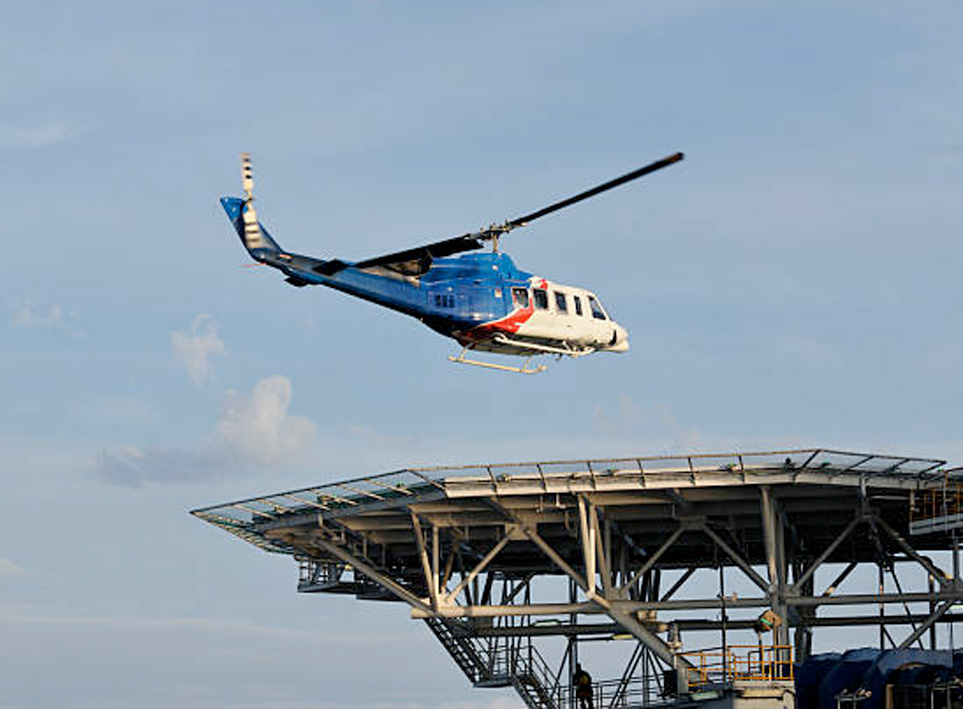In the world of aviation, safety is paramount. This is especially true when it comes to helicopter operations, which often involve landing on helidecks situated on offshore platforms, ships, and tall buildings. Here at Pro Friction Services, we specialise in maintaining these critical structures, and the importance of regular maintenance for helideck safety cannot be overstated. In this blog post, we take a look at the various aspects of helideck maintenance, highlighting why it is crucial for ensuring the safety of both personnel and equipment.
Understanding the Role of a Helideck
A helideck, also known as a helicopter landing deck, is a specifically designated area on a structure, such as an offshore oil rig or a ship, where helicopters can land and take off. These decks are critical for transporting personnel, equipment, and supplies to and from remote locations. Given the often challenging environmental conditions – such as high winds, saltwater exposure, and the potential for oil spills—the maintenance of these decks is essential to prevent accidents and ensure that they remain operational at all times.
The Consequences of Neglecting Helideck Maintenance
Neglecting helideck maintenance can have severe consequences. Over time, the harsh conditions that these structures are exposed to can lead to wear and tear, corrosion, and degradation of the deck surface. This can create safety hazards, such as reduced friction, which increases the risk of helicopter skids during landing and take-off. Additionally, structural integrity issues may arise, compromising the deck’s ability to support the weight of the helicopter and its cargo.
In the worst-case scenario, inadequate maintenance could lead to a catastrophic accident, resulting in loss of life, environmental damage, and significant financial losses. The reputation of the companies involved would also suffer, potentially leading to costly legal ramifications and a loss of trust from clients and stakeholders.
Key Components of Helideck Maintenance
Effective helideck maintenance involves several key components, all of which contribute to the overall safety and functionality of the deck. These include:
- Surface Friction Testing and Maintenance
The surface of a helideck must provide adequate friction to prevent helicopters from sliding, particularly in wet or icy conditions. Regular testing of the deck’s friction levels is essential to ensure compliance with safety standards. If the friction levels are found to be inadequate, surface treatments or repairs may be necessary to restore the required level of grip. - Structural Integrity Inspections
The structural components of the helideck, including support beams, joints, and the deck itself, must be regularly inspected for signs of corrosion, cracks, or other forms of damage. Any issues identified should be promptly addressed to prevent further deterioration and to ensure that the deck can safely support the weight of a helicopter. - Lighting and Markings
Proper lighting and clear markings are critical for the safe operation of helicopters, especially during night-time operations or in poor visibility conditions. Regular checks should be conducted to ensure that all lights are functioning correctly and that markings are visible and in good condition. Any defective lighting or faded markings should be replaced immediately. - Drainage Systems
Effective drainage is crucial to prevent the accumulation of water, oil, or other substances on the helideck, which could lead to slip hazards or reduced friction. Drainage systems should be inspected regularly to ensure they are clear of blockages and functioning as intended. - Firefighting Equipment
Given the potential for fuel spills and other fire hazards, helidecks must be equipped with appropriate firefighting equipment. This equipment should be regularly tested and maintained to ensure it is in good working order in the event of an emergency. - Regular Training and Drills
In addition to the physical maintenance of the helideck, it is important that personnel involved in its operation are properly trained and regularly participate in safety drills. This ensures that everyone is prepared to respond effectively in the event of an incident.
Compliance with Industry Standards and Regulations
In the UK, helidecks are subject to stringent safety regulations and industry standards, such as those set by the Civil Aviation Authority (CAA) and the Health and Safety Executive (HSE). Regular maintenance is not only a best practice but also a legal requirement to ensure compliance with these standards.
The Role of Pro Friction Services in Ensuring Helideck Safety
At Pro Friction Services, we understand the critical importance of regular helideck maintenance in ensuring the safety of helicopter operations. Our team of experienced professionals is dedicated to providing comprehensive maintenance services, including surface friction testing, structural inspections, and the upkeep of essential safety systems.
By partnering with us, you can rest assured that your helideck will be maintained to the highest standards, minimising the risk of accidents and ensuring the safety of all personnel and equipment involved in helicopter operations. We are committed to delivering reliable, high-quality services that meet the specific needs of each client, helping you to maintain a safe and compliant operating environment.
Whether you operate an offshore platform, a ship, or any other facility with a helideck, investing in regular maintenance is not just a regulatory requirement – it’s a fundamental aspect of ensuring the safety of your operations. If you’re in need of helideck friction services, please give us a call today on 07538933993, or drop us an email and we will get back to you as soon as possible.
